|
|
Brief information on
|
|
Nikon / Nippon Kogaku Japan Ultra-Micro-NIKKOR
1:4 f=155mm, Ultra-Micro-NIKKOR 1:2.8 f=165mm, Ultra-Micro-NIKKOR 225mm f/1.0,
Ultra-Micro-NIKKOR 250mm f/1.0 & Ultra-Micro-NIKKOR 300mm f/1.4 lenses
|
 |
Nippon Kogaku Japan, Ultra-Micro-NIKKOR 1:4 f=155mm
Year introduced: unknown; Discontinued: No info
This 155mm f/4 Ultra-Micro-NIKKOR was relatively unknown until one fine day,
I went through Mr Kelvin web library and was puzzled by the folder name UMN 155/4.
Anyway, Kelvin's that particular folder was actually empty with no images of that
specific lens - HOWEVER, he has a box with a front cap ! The 72mm cap can provides
some clue to roughly how its dimension was. I guess at this stage, important is at
least we know it exists and add up to this UMN lenses database, that is all.
Update: info extracted /added from Michio Akiyama website
Optical Consruction: 7 elements in 4 groups; Standard Magnification: 1/10X; Standard
wavelength: 546 millimicron e-line; Resolving power: 200 lines/mm @80mm image circle;
300 lines/mm @56mm image circle.Overall working distance: 1,822mm; Weight: 1,090g
<<<---The
closest photo of the Ultra-Micro-NIKKOR 1:4 f=155mm was this scanned image from the
Nikon Sales Manual of UMN lenses.
|
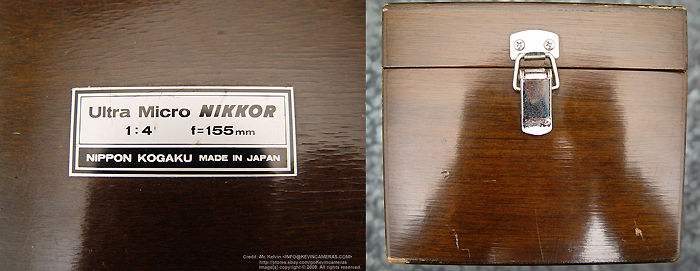 |
If anyone of you has pictures of this
lens, do consider to help us fill-up this empty slot in this site - so do other relative
models, Thank You.
|
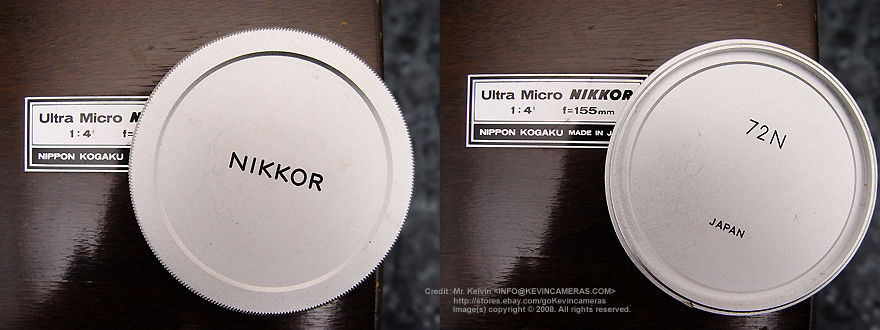 |
|
| |
|
 |
Nippon Kogaku Japan, Ultra-Micro-NIKKOR 1: 4 f=165mm e-line type;
Year introduced: 1970, Discontinued: No info
According to Nikon Hand Book by P.Braczko, the Ultra-Micro-NIKKOR 1:4 f=165mm
(165mm f/4) was introduced rather late in 1970 and according to his compiled listings
of one page summary of UMN lenses, the 165/4 was the last model being mentioned (but
may not neccessary means as the last among the UMN lens series). So if what Peter
mentioned was correct, the lens was actually introduced after the three exotic, ultra-fast
f/1.0~f/1.4 225, 250 and 300mm UMN. Another interesting fact is, this 165/4 has a
dedicated conversion kit and would alter the image size, wavelengths and the overall
weight. I cannot go further than this as I honestly don't know how it actually does
it functions with the conversion during operations.
|
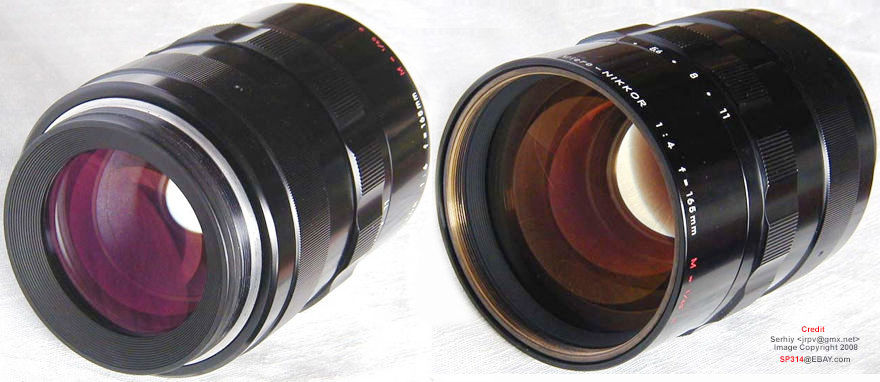 |
|
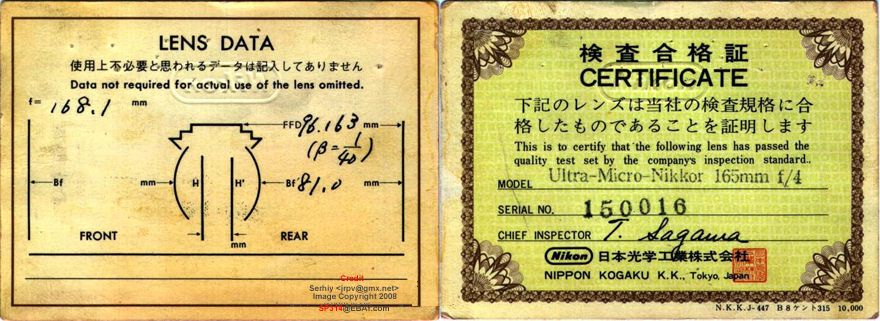
|
| |
|
|
Technical Specification of Ultra-Micro-NIKKOR 1:4 f=165mm e-line type
Focal Length: 167.8mm
Maximum/minimum Aperture: f/4, f/11
Lens Construction: 7 elements in 4 groups
Standard Magnification: 1/40X
Picture Angle: °
Overall working distance: 7,000mm
Object area:- 2,240mm @ f/4; 3,200mm @ f/5.6
image area:- 56mm @ f/4; 80mm @f/5.6

|
Standard wavelength: 546milli-micron (e-line);
Aperture efficiency at image corner: 100% @ f/4, 0% vignetting
Distortion: - +0.02% @56mm image circle; - 0.03% @ 80mm image circle
Aerial resolving power:
350 lines/mm @f/4;
200 lines/mm @ f/5.6
Aperture scale: f/4, f/5.6, f/8, f/11
Lens Mount: Screw d=62mm p=1mm; Adapter Plate: o.d. =77.5mm
Dimension (D) X (L):- no info
Filter thread size: 86mm
Weight:- 830g
Conversion lens kit M=1/20X:-
Focal Length: 169.1mm
Overall working distance: 3,678mm
Fixed Aperture: f/11
Lens Construction: 9 E 5 Gs
Standard Magnifications: 1/20X
Standard wavelength: 546.1 millimicron
Resolution: 350 lines/mm f/4; 200 lines/mm f/5.6
Object area:-
1,120mm @ f/4; 1,600mm @ f/5.6
image area:- 56mm @ f/4; 80mm @f/5.6
Weight/Dimension: 2,200g
|
Nippon Kogaku KK Japan, Ultra-Micro-NIKKOR 1:1.0 f=225mm; Nippon Kogaku KK Japan,
Ultra-Micro-NIKKOR 1:1.0 f=250mm; Nippon
Kogaku KK Japan, Ultra-Micro-NIKKOR
1:1.4 f=300mm; Year introduced:
1968~1969, Discontinued: No info
Probably stands to claim as among the FASTEST lens series that Nikon had ever produced.
I don't have any photos to show as I am short of resources. If you are observant,
all these few lenses have one thing in common i.e. tele-range and very large aperture.
If we go back to the introduction page and referred back to the basic theory... "Lens
Speed in its relation to Resolution", may be we can understand why there
were development of these super-Nikkor lenses:-
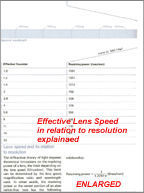 |
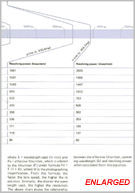
|
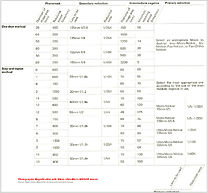 |
Why would it need such a high lens speed like 225mm
f/1.0, 250mm f1.0 and 300mm/1.4 ? Nikon explained :- " ..Where  =wavelength used (in mm) and Fe (effective
f/number), which is related to the f/number (F) under formula Fe=F(1+M)
("M" =photographing magnification). From this equation, the faster the
lens speed, the higher the resolution. Similarly, the shorter the wavelength used,
the higher the resolution. The chart presented the relationship between the effective
f/-number, operating wavelength ( =wavelength used (in mm) and Fe (effective
f/number), which is related to the f/number (F) under formula Fe=F(1+M)
("M" =photographing magnification). From this equation, the faster the
lens speed, the higher the resolution. Similarly, the shorter the wavelength used,
the higher the resolution. The chart presented the relationship between the effective
f/-number, operating wavelength (  and resolving power when calculated from the
formula..". and resolving power when calculated from the
formula..".
|
| |
|
|
|
<<<--- Above left image: Relationship between the effective
f/-number, operating wavelength (64k Gif); Far left: Relationship of an aberation-free
lens and resolving power at the center . Last chart: Photographic Magnification reference
chart for various UMN lenses in one-shot or step & repeat process. Photomask
and wafer printing/ one shot and step and repeat process in large scale IC/LSI manufacturing.
Note: A micrometre is one-millionth of a metre (1/1000 of a millimetre,
or 0.001mm). Its unit symbol in the International System of Units (SI) is µm.
The nanometre was formerly called also millimicron,since it is 1/1000 of a micron,
and was often denoted by the symbol mµ or (more rarely) µµ. or
A unit of length equal to one thousandth (10-3) of a micrometer or one billionth
(10-9) of a meter. (Mathematics & Measurements / Units) an obsolete name for
a nanometre; one millionth of a millimetre. Useful links: What Wavelength Goes With a Color?
LACK of further technical info as well as pictures of physical lenses
for a proper web page, takes a pause here, until I can find more data that relates. |
| BACK | 6/7 Nippon Kogaku K.K. Ultra-Micro-Nikkor
Series @ 165,
225, 250 & 300mm focal length
Index Page:
Nippon
Kogaku K.K. S-Mount rangefinder version Micro-NIKKOR.C 1:3.5 f=5cm (50mm f/3.5)
Page 1:- Micro-NIKKOR
70mm f/5 / Micro-NIKKOR 150mm/5.6 / Macro-NIKKOR Series
:- 19/2.8, 35mm f/4.5, 65mm/4.5, 120mm f/6.3
Page 2:- Ultra-Micro-NIKKOR
Series -28mm focal length models
Page 3:- Ultra-Micro-NIKKOR
Series - 29.5/30mm, 50 & 55mm focal length models
Page 4:- Ultra-Micro-NIKKOR
Series - 105, 125, 135mm & 150mm focal length models
Page 5:- Ultra-Micro-NIKKOR
Series - 155, 165, 225, 250 & 300mm focal length models
Page 6:- General information on other special purpose NIKKOR lenses for industrial.
technical and science applications
Nikon RF-Nikkor lenses:- Main Index Page
W-Nikkor-O 1:4 f=2.1cm | W-Nikkor.C 1:4 f=2.5cm | W-Nikkor.C
1:3.5 f= 2.8cm | W-Nikkor.C 3.5cm lens Group (3.5/2.5/1.8) | Stereo-Nikkor 1:3.5 f=3.5cm | 5cm (50mm) lens group | RF Micro-Nikkor 1:3.5 f=5cm (in progress) | Nikkor-P.C 1:2 f=8.5cm lens group / Nikkor-S.C 1:1.5 f=8.5cm lens group | Nikkor-P.C 1:2.5 f=10.5cm
lens group / Nikkor-T 1:4 f=10.5cm | Nikkor-Q.C 13.5cm lens group: 135/4, 135/3.5 Early
/ Last Version, 135/4 Bellow lens
| Nikkor-H 1:2.5
f=18cm | Nikkor-Q 1:4 f=25cm
| Nikkor-T 1:4.5 f=35cm | Nikkor-T.C 1:5 f=50cm | Reflex-Nikkor 100cm f/6.3
System Accessories
for Nikon Rangefinder cameras
Optical Finders (4 parts):- Fixed Focal length Finders (index page): 2.1cm,
2.5cm, 2.8cm,
3.5cm, 35cm Stereo,
5cm, 8.5cm, 10.5cm,
13.5cm | Variframe / Varifocal / Sport-frames
| Nikon Reflex Housing
Nikon
S36/S72/S250 Motor Drives
/ S36 Manual |
light meters | Nikon RF Flash/Speedlights | Close-up
photography / Repro Copy Outfit / Nikon Bellow Focusing Device (in progress) | Cases/Compartments | Lens & body caps,
Lens Hoods/shades,
Original Price Lists |
packaging/boxes
Instruction
Manuals
RELATIVE:- Nikon Rangefinder (RF) Models | Pictorial History of Nikon
A small visual library on
Nikon Ultra-Micro-Nikkor lenses
Manual Focus Nikkor lenses | Autofocus
Nikkor lenses
Related info:- Leica/Leitz
| Contax/Carl
Zeiss | Seiki Kogaku
(Canon)
| Message Board | lenses | Message Board | RF cameras
Nikon
Auto
Focus
Nikkor lenses:- Main Index Page
Nikon Manual
Focus
Nikkor lenses:- Main Index Page
| Back | Main
Index Page of Pictorial History of Nikon SLRs
about this photographic web site
 |
Home - Photography in Malaysia
|

Credit:- Special thanks to all the contributors of images
and content which made up the basis of the site. Note:certain content and
images appeared in this site were either scanned from official marketing leaflets,
brochures, sales manuals or publications published by Nikon over the years and/or
contribution from surfers who claimed originality of their work for educational purposes.
The creator of the site will not be responsible for may discrepancies arise from
such dispute except rectifying them after verification."Nikon",
"Nikkormat", "Nippon Kokagu KK" & "Nikkor"
are registered trade name of Nikon Corporation Inc., Japan. Site made with an Apple
G5 IMac.
|